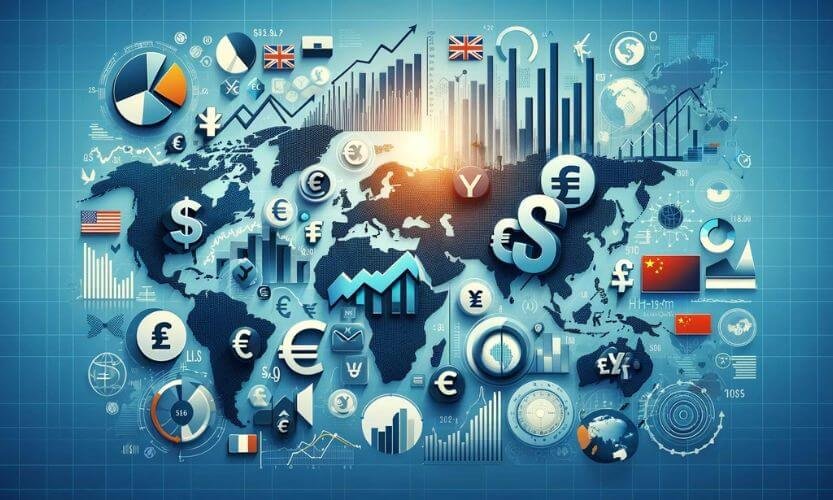FxNews – In autumn 2008, I walked with my best friend, Adel. We were chatting about subjects I no longer remember, perhaps because they weren’t necessary. As we approached our houses in the old neighborhood, Adel introduced a name into the conversation that I had never heard before. He said there was a new trending business in the world: Forex. It was the first time I heard that name, a moment I’ll never forget. My initial response was, “What is Forex?”

What is Forex?
Adel’s eyes sparkled with excitement, and he was eager for me to ask. He enthusiastically explained that Forex involves buying and selling currencies in the global financial market. It’s a vast and highly liquid market accessible to individual and institutional traders worldwide through online platforms.
Interestingly, hundreds of currencies are available for trade, from the South African Rand to the Euro and from the Japanese Yen in the east to the American dollar iDollarwest. Every currency we can think of can be traded in the blink of an eye. The traditional method of trading Forex, which required buying or exchanging currencies through a bank, is being replaced. Thanks to the internet, the process can now be completed with just a few clicks.
Forex, short for foreign exchange, is the market where currencies are traded. It’s one of the largest and most liquid financial markets in the world.
How Global Financial Market Fuel the Economy
The global financial market is an extensive network where people trade money-related items. These include shares in companies, loans, currencies from different countries, essential goods, and other complex financial products. The global financial market is vital for the economy because it helps move money and resources from one country to another.
What are trading pairs?
The currencies are traded in couples or pairs. They are generally called ‘currency pairs.’ The concept of trading currency pairs is to buy or sell one currency against another. This means when you trade, you buy one currency type while selling another simultaneously.
Example: Imagine the current exchange rate for EUR/USD is 1.10. This rate means 1 Euro (EUR) equals 1.10 US Dollars (USD). You might buy this pair if you believe the Euro will strengthen against the Dollar. Dollarchasing, you’re essentially buying Euros and selling US Dollars.
For instance, if you buy 1000 Euros at this rate, you’ll spend 1100 US Dollars (1000 Euros * 1.10 USD/Euro). If the exchange rate later rises to 1.15, your 1000 Euros will now be worth 1150 US Dollars.
If you decide to sell your Euros at this new rate, you’ve made a profit, as you initially spent 1100 USD, and now you have 1150 USD.
On the flip side, if the Euro weakens and the exchange rate drops, let’s say to 1.05, your 1000 Euros would then be worth only 1050 USD. Selling at this point would mean a loss, as you initially spent 1100 USD, but now you only have 1050 USD.
We used EUR/USD for this example because it is one of the most popular currency pairs in the world. If you wish to learn more about currency pairs, I suggest reading my article, Understanding Currency Pairs.
Market Size and Liquidity in Forex
Forex is the biggest financial market globally. To understand its size, think about this: more than 5 trillion US Dollars are traded there daily. That’s a tremendous amount of money, much more than what’s traded on stock markets like the New York Stock Exchange.
The massive liquidity makes the forex market stand out from other markets. Trading in a high-liquidity market is more accessible because traders can buy and sell currencies without affecting the prices too much. Since much trading happens constantly, traders can quickly trade large amounts of money.
Example: Imagine you’re a Forex trader focusing on the Euro and the US Dollar (EUR/USD). One morning, you hear that the European economy is doing better than expected. This is good news for the Euro, and you predict its value will go up against the US Dollar.
At the start of the day, the exchange rate is 1 Euro = 1.10 US Dollars. Expecting the Euro to strengthen, you decide to buy 1,000 Euros. This purchase costs you 1,100 US Dollars (1,000 Euros * 1.10 USD/Euro).
Your prediction turned out to be correct. Thanks to the positive economic news from Europe, the value of the Euro went up. By the afternoon, the exchange rate had changed to 1 Euro = 1.15 US Dollars.
Your 1,000 Euros are worth 1,150 US Dollars (1,000 Euros * 1.15 USD/Euro). You decide to sell your Euros at this new, higher rate. You initially spent 1,100 US Dollars, but after selling your euros, you now have 1,150 US Dollars, making a profit of 50 US Dollars.
Forex Market Drivers and Trends
Let’s break down what drives changes in the Forex market into simpler terms.
Economic Indicators are like a report card for a country’s economy. Financial indicators like Gross Domestic Product (GDP), employment rates, and inflation show how well a country’s economy performs. If the report card is sound (like high GDP or low unemployment), the country’s currency might strengthen. If it’s not so good (like high inflation), the currency might weaken.

Interest Rate Decisions by Central Banks
Think of central banks as the school principals of the economy. They make big decisions, like setting interest rates. If a central bank raises interest rates, it can make the country’s currency more attractive to investors. More demand for the currency usually increases its value.
Political Events: Political events can change the value of a currency. Elections, changes in government, or political tensions can make investors feel either positive or negative about a currency, affecting its value.
Natural Disasters: Imagine if something unexpected happens, like a power outage. This can disrupt your typical day. Similarly, natural disasters (like earthquakes or floods) can disrupt a country’s economy, affecting its currency’s value.
Leverage in Forex
Forex trading is often leveraged, meaning traders can control prominent positions with relatively little capital. This can amplify profits but also increase the potential for significant losses.
If you wish to learn more about leverage in Forex, please read this article: ‘What is Leverage in Forex?‘
Forex: 24/5 Round the Clock Market
Unlike stock markets with specific hours and locations, the forex market operates 24 hours a day, five days a week. This continuous operation is possible because the market isn’t tied to a single physical location; it’s a network of banks, brokers, and traders worldwide.
The forex market opens on Sunday evening when the financial markets in Sydney, Australia, start their week and closes on Friday evening in New York as the American markets finish their week. This cycle allows continuous trading as different financial centers worldwide open and close throughout the day and night.

The forex market is typically segmented into three major trading sessions:
Asian Session: This session starts with the opening of the Sydney market, followed by Tokyo. Major financial centers in this session include Sydney and Tokyo. Currencies from the Asia-Pacific region see more movement during these hours.
European Session: Also known as the London session, this session overlaps with the late Asian session. London is a significant financial hub, so this session often sees the highest volume of trading and, as a result, high volatility. This session includes cities like London, Paris, and Frankfurt.
North American Session: This session begins with opening the New York market. Other major active financial centers during this session included Chicago and Toronto. The North American session overlaps with the late European session, often leading to significant movements in currency pairs, especially those involving the US dollar.
How It All Connects
As one session closes, another opens or is already open, creating a continuous loop of trading opportunities. For example, when the Asian session is winding down, the European session starts. Similarly, as the European session ends, the North American session gets in full swing. This overlap between sessions often results in higher trading volumes and volatility, making these times attractive for traders.
Key Points
- Continuous trading is possible due to the different time zones of major financial centers.
- The overlap between sessions often leads to increased trading volume and price movement.
- Each session has unique characteristics based on the active economies during those hours.
Who are the Participants in the Forex Market
Forex is a worldwide network where retail traders and organizations exchange different types of money. The participants in this market are pretty diverse, ranging from big players to individual traders. Let’s break it down:
Large Financial Institutions: These are the big banks and financial companies. They play a significant role in forex trading, dealing with massive amounts of money. Their main goal is often to profit from speculating on the changing values of currencies.
Multinational Corporations: These are large companies that operate in multiple countries. They’re not primarily in the forex market to make a profit from currency changes. Instead, they need to exchange currencies for practical reasons, like paying for goods and services in other countries or converting profits made overseas into their home currency.
Individual Retail Traders: These are everyday people like you and me who participate in the forex market, often as a way to earn a profit. We trade much smaller amounts of money compared to large institutions or corporations. We use our judgment, research, or even automated systems to guess which way currency values will go and try to make a profit from these changes.
Speculation in Forex Trading
Forex trading involves exchanging different currencies and attracts many people who aim to profit by predicting how currency values will change. Here’s a detailed but straightforward explanation of this:
Predicting Currency Movements: Just like someone might try to guess which way a stock’s price will go, Forex traders try to predict whether a currency will go up or down in value compared to another currency.
For example, if they think the Euro will increase in value against the US Dollar, they’ll buy Euros.
Making Profits from Fluctuations: These predictions aim to make money from the changes in currency values. If a trader’s prediction is correct and the currency’s value changes as expected, they can sell it for a profit. If their guess is wrong, they may lose money.
Forex trading isn’t easy and comes with significant risks:
Market Volatility: The Forex market can be very unpredictable. Prices of currencies can fluctuate wildly due to factors like economic reports, political events, or global crises. If you want to know about ‘The Most Volatile Currency Pairs,’ I suggest clicking the link and reading the article.
Complexity: Understanding why and how currencies change in value requires extensive knowledge of international economics, politics, and finance.
To be successful in Forex trading, one needs more than just luck:
Understanding the Forex Market: A trader must understand how the Forex market works, including factors that influence currency values.
Solid Strategy: It’s crucial to have a well-thought-out trading strategy. This means knowing when to buy or sell and setting clear goals.
Risk Management Practices: Successful traders know how to manage their risks. This can include limiting their losses, diversifying their investments, and not putting all their money into one currency or trade.
Accessibility: Democratizing Forex
In the past, trading in this market was mainly for big banks or wealthy individuals because it was complex and challenging to access. But now, thanks to the internet, things have changed dramatically.
Accessibility in Forex trading means that almost anyone with a computer or smartphone can participate now. It’s like having a currency exchange shop right in your home. This change is primarily due to online trading platforms – particular websites or apps designed for currency trading.

These platforms are like powerful tools or assistants for your trading journey. They do several things:
Analysis Tools: They provide charts and data to help you understand market trends. Imagine looking at a weather app before carrying an umbrella; these tools do something similar for currency markets.
Trading Mechanisms: They allow you to buy and sell currencies quickly. You can trade with just a few clicks or taps, much like purchasing from an online store.
Risk Management Features: Trading involves risks, like the chance of rain during a picnic. These platforms offer features to help manage these risks, like setting limits on how much you can buy or sell or at what price you want to enter or exit a trade.
Regulation in the Forex Market
Regulation refers to rules and laws set by authorities. These rules are designed to keep the market safe and fair for everyone.

Why is Regulation Important in Forex?
Protects Traders: Regulations ensure that brokers (the middlemen in Forex trading) treat traders fairly and don’t engage in fraudulent activities.
Maintains Market Stability: It helps keep the market stable, even during economic turbulence.
Prevents Manipulation: Regulations aim to prevent price manipulation, ensuring that no single entity can unfairly influence currency prices.
How Does Regulation Affect the Market?
Different countries have their regulatory bodies (like the SEC in the U.S., FCA in the U.K., etc.). These bodies set rules on how brokers can operate. For example, they might limit a trader’s leverage (borrowed money). Regulations also dictate how much transparency is required, meaning brokers must provide transparent information about their services and the risks involved in Forex trading.
Forex Regulation and the Impact on Traders
Traders need to choose brokers that are regulated in their country. This offers them protection and recourse in case something goes wrong. Due to these regulations, they might find that certain trading practices are restricted or that they need to provide more documentation.
Final Words
Let’s wrap up this fascinating dive into Forex trading, a journey that began with a simple chat with my friend ‘Adel’ in the autumn of 2008. Who knew a casual conversation could open the door to such a thrilling and complex universe? Forex, this global dance of currencies, is more than just numbers and charts.
This market is enormous—trillions are traded daily, and it’s not just for the big players; thanks to the internet, anyone with a phone can participate. It’s like having a 24-hour currency exchange in your pocket!
Think of Forex as a never-ending global party where the music never stops. It’s a round-the-clock exchange, buzzing with activity from Sydney to New York, with each region adding its unique flavor to the mix.
What drives this market is a cocktail of factors – from a country’s economic health to significant political changes, even unexpected events like natural disasters. It’s like a real-time pulse of our world’s events, reflected through currency movements.
Forex is like a high-speed roller coaster – thrilling but not without risks. That’s where the art of strategy and the science of risk management come into play.
Let’s not forget the guardians of this financial universe—the regulations. They’re like the rules of the road, keeping everything in check so the journey is fair and safe.
From that memorable walk in 2008 to now, exploring Forex has been an adventure. It’s a vibrant market that mirrors our world’s economic heartbeat, constantly evolving and full of surprises.